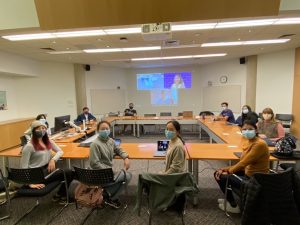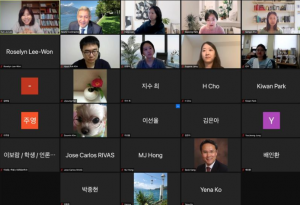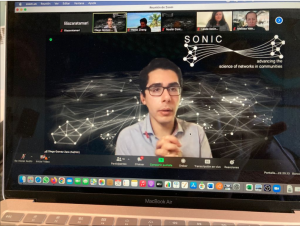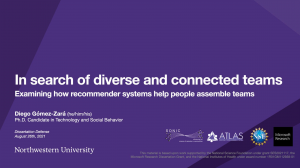SONIC is looking to bring as many as four podcast producers/editors onto our team! These people will work with SONIC on new shows launching on the International Communication Association Podcast Network. See the below description for more details!
Northwestern Magazine & PSA Features
SONIC’s space research has been featured in the current issue of the Northwestern magazine, as well as a couple Northwestern PSA videos! All of these can be found at northwestern.edu/mars ,
, and
SONIC Meets In-Person Again
We are so excited to be able to offer an in-person option for our lab meetings again! Yesterday was our first hybrid SONIC lab meeting since March of 2020.

SONIC Fall 2021 Recruitment
SONIC is excited to look for more data science interns to add to our team! If you are interested in advancing the social network theory through the development of cutting-edge techniques alongside a passionate team of individuals, check out the form here and see how to get involved!
Contractor Presents at International Scholars Seminar Series
This past Monday August 30th, Noshir Contractor presented the lecture “Reimagining Theories and Methods to Understand and Enable the Algorithmically Infused Changing Nature of Work” in the International Scholars Seminar Series for BK21 FOUR at Seoul National University!

Diego Gómez-Zará defends dissertation
A huge congratulations goes out to Diego Gómez-Zará for his PhD defense! His dissertation focuses on examining how recommender systems help people assemble teams. The dissertation committee included SONIC’s own Noshir Contractor, as well as Leslie DeChurch and Haoqi Zhang of Northwestern University, in addition to Melissa Valentine of Stanford University.


Contractor Recognized with Honors from ICA and INSNA
Congratulations to SONIC Director Noshir Contractor for his honors both with the Fellows Book Award from the International Communication Association and with the Simmel Award from the International Network for Social Network Analysis! More on this in the following Northwestern McCormick School of Engineering article: https://www.mccormick.northwestern.edu/industrial/news-events/news/articles/2021/contractor-receives-honors-from-ica-insna.html
Contractor Giving a Keynote at Global Research Forum 2021
SONIC Director Noshir Contractor will be presenting a keynote on “Reimagining Theories and Methods to Understand and Enable the Algorithmically Infused Changing Nature of Work” for National University of Singapore’s Global Research Forum 2021! Be sure to join the forum running from August 23-25, with Noshir’s presentation on August 24.
Register here: https://nus-sg.zoom.us/webinar/register/WN_QYUf8OIbTo6fcGaEFpx7Ew?_x_zm_rtaid=Voe3Q3vPTcOXJ-Z14nyzqA.1629392617169.21390693421fefc137a8df623d8f77e4&_x_zm_rhtaid=136
Contractor Appointed Associate Editor of PNAS Nexus
Congratulations to Professor Contractor for his appointment as Associate Editor of PNAS Nexus, a National Academy of Sciences journal from 2021 to 2024! Noshir will be the Associate Editor for Social/Political Sciences and the rest of the Editorial Board can be found here: https://academic.oup.com/pnasnexus/pages/editorial-board
Professor Contractor at the U. S. National Academies Committee on Addressing Misleading Information and Infectious Disease Outbreaks and Biological Threats
In the midst of the Covid-19 pandemic, Professor Contractor presented at the U.S. National Academies Committee on Addressing Misleading Information and Infectious Disease Outbreaks and Biological Threats. His presentation, titled “Increasing Awareness about Network Awareness in Scientific Networks,” focuses on why a lack of “Network Awareness” may lead to failures in scientific networks and how technological affordances and algorithmic recommendations can make scientific networks more effective. The virtual presentation can be found here:
